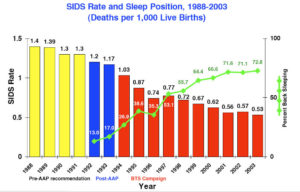1. Place your baby on his or her back for all sleep times—for naps and at night. Some parents may be concerned that a baby who sleeps on his or her back will choke if he or she spits up during sleep. However, babies’ anatomy and gag reflex will prevent them from choking while sleeping on their backs.
Babies who sleep on their backs are much less likely to die of SIDS than babies who sleep on their sides or stomachs.

Place your baby on the back for all sleep times for naps & at bedtime.
2. Use a firm sleep surface, such as a mattress in a safety-approved crib or bassinet, covered only by a fitted sheet. Some parents might feel like they should place their baby on a soft surface, such as memory foam, to help him or her to be more comfortable while sleeping. However, soft surfaces can increase the risk of sleep-related death. A firm sleep surface helps reduce the risk of SIDS and suffocation.
3. Have the baby share your room, not your bed. Your baby should not sleep in an adult bed, on a couch, or on a chair alone, with you, or with anyone else. Some parents may feel like they should share their bed with their baby to help them feel more connected. However, accidental suffocation, strangulation, and wedging (for example, being stuck between two objects such as a mattress and a wall) can happen when a baby is sleeping in an adult bed or other unsafe sleep surfaces. Room sharing is much safer than bed sharing and may decrease the risk of SIDS by as much as 50%.
4. Keep soft objects, such as pillows and loose bedding out of your baby’s sleep area. Some parents may feel they should add soft objects to their baby’s crib to help keep their baby warm and comfortable while sleeping. However, soft objects and loose bedding, like stuffed toys, sheets, comforters, and blankets, can increase the risk of suffocation and other sleep-related deaths. If you’re worried about your baby getting cold during sleep, you can dress her or him in sleep clothing (like a wearable blanket) to keep your baby warm.
5. Do not allow smoking around your baby. Smoke in the baby’s surroundings is a major risk factor for SIDS. Quitting smoking can be hard, but it is one of the best ways parents and caregivers can protect their health and their baby’s health. For help in quitting, call the quitline at 1-800-QUIT-NOW (1-800-784-8669) or visit smokefree.gov.
6. Breastfeed as Long as You Can
Breastfeeding your baby can lower the risk of SIDS by as much as 50%, though experts aren’t sure why. Some think breast milk may protect babies from infections that raise their SIDS risk. Do not drink alcohol if you breastfeed, because that raises your baby’s risk of SIDS. In addition, the simple touch is helpful. Skin-to-skin contact is important for your baby’s development.
7. Immunize Your Baby
Evidence shows babies who’ve been immunized in accordance with recommendations from the American Academy of Pediatrics and the CDC have a 50% reduced risk of SIDS compared with babies who aren’t fully immunized.
8. Consider Using a Pacifier to Put Baby to Sleep
Putting your baby to sleep with a pacifier may also help prevent SIDS, though researchers aren’t sure why. There are a few tips to follow when using a pacifier:
- If you’re breastfeeding, wait until your baby is breastfeeding regularly (at least 1 month old) before starting to use a pacifier. Introducing a pacifier too soon can lead to nipple confusion and cause your baby to prefer the pacifier’s nipple over your own.
- Don’t force your baby to take the pacifier if he doesn’t want it.
- Put the pacifier in your baby’s mouth when you put him down to sleep, but don’t put it back in his mouth after he falls asleep.
- Keep the pacifier clean, and buy a new one if the nipple is damaged.
- Don’t coat the pacifier with honey, alcohol, or any other substance.
9. Keep Your Baby From Overheating
Because overheating may raise a baby’s risk of SIDS, dress your infant in light, comfortable clothes for sleeping, and keep the room temperature at a level that’s comfortable for an adult.
If you’re worried about your baby staying warm, dress him in a “onesie,” pajamas that cover arms, legs, hands, and feet, or place him in a “sleep sack” (a wearable blanket). However, don’t use a regular blanket — your baby can get tangled in it or pull the blanket over his face.
10. Steer Clear of Products That Claim to Reduce the Risk of SIDS
It’s best to avoid any product that says it can lower your baby’s risk of SIDS, because they haven’t been proven safe or effective. Cardiac monitors and electronic respirators also haven’t been proven to reduce SIDS risk, so avoid these, too.
11. Don’t Give Honey to an Infant Under 1 Year Old
Because honey can lead to botulism in very young children, never give honey to a child under 1 year old. Botulism and the bacteria that cause it may be linked to SIDS.
Remember, your baby’s health care provider is always available to answer any questions you have about SIDS, SIDS prevention, and keeping your baby warm, happy, and safe.
